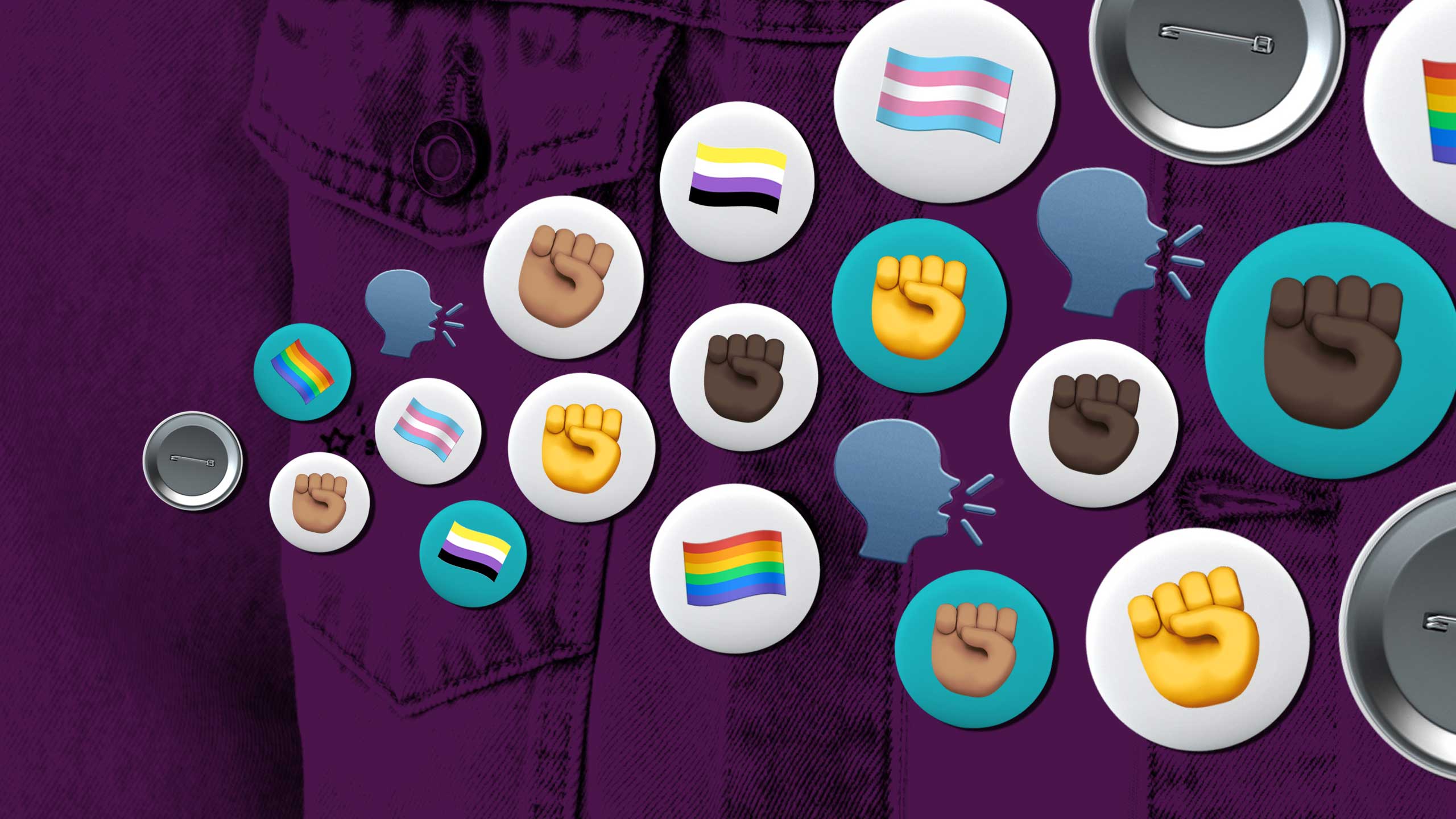A warning to readers: Parts of this story deal with attempted suicide.
I came out as non-binary around the same time my mental health plummeted. In the summer of 2016, I was in the process of moving to Toronto from a small city on Vancouver Island. I didn’t have much of a plan—I just packed the remains of my 25 years in B.C. into the back of my two-door Pontiac and began to drive. I wandered the highways of Canada searching for a similar vastness within myself, and after months of solitude, a truer expression of myself began to breathe. But the attempt to rediscover myself was like the removal of a dam, letting all my long-suppressed issues come crashing through unchecked. It meant my first few years in Toronto involved a considerable amount of time in hospital wards, emergency rooms and therapy programs at a time when I still used my old name and had little capacity for self-advocacy.
I trusted doctors and mental health professionals to understand that my crisis visits were not a direct consequence of my queerness. I was shocked when one ER doctor spent eight out of our precious 10 minutes asking about my “transition” (I don’t identify as trans nor was I medically transitioning) and inquiring repeatedly if I was going from male to female or female to male; he simply could not wrap his head around the answer being “neither.” After educating him, our remaining time was only enough to cover how much longer I’d be waiting in a random hallway before I got a bed in the ward. I was brought to the hospital by police because I tried to kill myself on the side of the highway—but that never came up. The doctor was more concerned with my gender.
For a while I sought help in all available ways I could find in Ontario’s mental health care system. I jumped through all of the hoops: I instructed a psychiatrist on the diagnosis I needed for the therapy program that was supposed to help me; I accepted an additional diagnosis of gender dysphoria because I was learning that the more diagnoses you have the more likely you’ll get helped; and I let triage nurses and receptionists use incorrect pronouns in waiting rooms to save myself time. Triage nurses always input the legal name and sex from my health card; when the doctor called my legal name I wanted to hide and pretend they were calling someone else. On the intake forms, I often sat and debated: Could I get away with not ticking either the “male” or “female” box?
Like many queer and trans people, these microaggressions are part of my daily life. Marginalized individuals and communities are all too familiar with microaggressions—the small, daily instances of discrimination or prejudice. Regardless of whether microaggressions within the mental health care system are intentional or stem simply from ignorance, they culminate in mistreatment of LGBTQ2S+ patients and a higher risk of suicide attempts.
I was able to shrug off some microaggressions in the moment, but they inevitably seeped between the cracks of my self-confidence. Harder to shake were the experiences I had in a year-long group therapy program: I was initially eager to be receiving treatment that was supposed to help, but several instances of microaggressions quickly transformed that eagerness into dread and anxiety each time I had to attend the group.
The first day of the program, I had to meet with the group leaders to explain my identity and how I wanted to be referred to. At first it seemed like a good start—the leaders of the group had us all write our names and pronouns on cards placed at the table for everyone to see each week. But no one respected my pronouns. Not the other participants, nor the group leaders. Most people used the pronoun they decided fit their assumptions about me, or people avoided using pronouns at all by referring to me by name in that awkward-but-obvious way people have when they can’t decide where you fit.
“Microaggressions go on and on, isolating me within settings that are supposed to be therapeutic.”
Halfway through the program I had to change groups due to scheduling conflicts. In the new group, here was one other queer person. Suddenly everyone, including group leaders that knew me from the prior program, started mixing up our names. This perception that all queer people look the same is unfortunately very familiar to me: I’ve encountered this with professors, employers, friends and strangers who call my partner and I by each other’s name.
The assumption of heteronormativity was alive and well in this therapy program. From the workbooks and readings we used in group (which didn’t include examples involving queer people) to the additional books and resources that primarily addressed a straight female subject, all of it perpetuated this heteronormative assumption.
The organization I accessed therapy through has a file on me that began in 2017. Even though my preferred name was known to them and was used within every group or individual setting, their “system” (in quotes because it seems like a pretty fragile excuse) still defaulted to my deadname. It’s appalling that years later, any time I’m referred to someone else within this organization, I have to explain to them again that they’re using the wrong name for me.
These microaggressions go on and on, isolating me within settings that are supposed to be therapeutic. It’s well-documented that these microaggressions against those most vulnerable to mental illness often lead to poorer treatment within the system or to them avoiding seeking help entirely. I know I should not have to fill the role of both patient and educator, yet years of experience have led me to conclude that this is my reality. What I didn’t realize is that I could do something about it: I could be silent and let the problem grow, or I could contribute to the solution.
I know it’s not that easy. When my mental health was at its worst, I didn’t have the energy to fight the system or educate every individual care provider. The big ways people are fighting this inequality through traditional forms of activism, like protests and lobbying for legal change, can seem intimidating—not everyone has the time, energy or resources to do this. The mental health care system is complex and requires a resourceful patient to navigate it. On top of that, most health care practitioners are not trained to work with LGBTQ2S+ patients. Extensively using the mental health care system while exploring my interest in human rights, law and activism means I now have the tools and conviction to speak up for myself in a way I didn’t understand before. As my mental health began to stabilize, I started to see that there are smaller ways to combat daily discrimination toward queer and trans people, through microaggression’s opposite: Microactivism.
While I was still in the therapy program and looking for work, I got a job offer. It was immediately revoked when I told the business owner my pronouns are they/them. I sued, and the case was settled in my favour because a recent law backed me up. This opened my eyes to a perspective I hadn’t considered before: Traditional activism creates laws, but microactivism creates change.
For example, if it’s made illegal to discriminate against someone for their pronouns, it’s still up to the person who was discriminated against to speak up. Otherwise, these legal protections are just hard-earned paperweights. If I had silently accepted the loss of a job, nothing would have changed and the person who discriminated against me would have gone on none the wiser; they would have realized that there are no repercussions if they discriminate against someone who uses they/them pronouns, likely adding fuel to their wrongful treatment of others.
When I tell people I sued someone, I’m told it’s “amazing” and “courageous” that I stood up for myself and didn’t let people mistreat me. That reaction feels overblown, because it began as the smallest act of microactivism. Instead of letting this person assume my pronouns, I told them how I wish to be addressed. It all started with a tiny moment where I chose to say something instead of nothing.
That’s all microactivism is: It’s small moments of making yourself visible. It’s existing unapologetically in every moment and circumstance—and, sometimes, it’s using those moments to push for individuals or businesses to be held legally accountable. Microactivism is the foundation on which traditional activism stands.
Since traditional activism isn’t a comprehensive strategy for everyday scenarios, I think people tend to mentally separate activism from everyday life. Microactivism, then, bridges the gap between traditional activism and simply living as we are each day; it challenges the foundation of prejudice and discrimination. Microactivism can be as small as wearing a pin declaring your pronouns (which I did when I got exasperated with willfully ignorant co-workers) or ensuring you use respectful and inclusive language at all times, not just when you’re in public. It’s telling your friends or family when they use offensive language. It’s remembering that identifying as queer or trans doesn’t prevent you from making harmful assumptions or comments about other queer or trans people.
When it comes to mental health care, remember that care providers may not be hyper-aware of queer and trans microaggressions (even though they should be), so you may notice slights that they don’t. Maybe they are merely ignorant and don’t mean harm—or even intend to help—so give them the benefit of the doubt. This is not to be confused with letting it go. I suggest calling attention to microaggressions as a form of raising a care provider’s self-awareness.
“Visibility is one of the most important things in a social movement and our fight for change.”
People—care providers and clients alike—need to collectively focus on microactivism because it will force us to look within ourselves, to consider our day-to-day thoughts and actions. Instead of blaming the world in general, start small: Do something, however minor it may seem. It’s not our fault and we aren’t responsible for the discrimination that harms us, but when microaggressions happen, it is more effective to say something. Saying something—even the smallest correction—can make the difference between you being a visible or invisible queer person. And we know visibility is one of the most important things in a social movement and our fight for change.
(It’s important, of course, to use your discretion to identify the moments you are mentally or physically able to take a small action or speak up. Sometimes it is actually unsafe for activism or visibility of any kind, and sometimes we don’t have the mental energy to engage. While you don’t have to use microactivism every chance you get—we are human and it’s okay that sometimes it’s too much—remember your contribution can be as small as questioning your own thoughts.)
I continue to work on my own ability to say something and hold myself accountable. I try to pay attention to my thoughts and assumptions about other people, and, if I’m not sure about something, to seek answers instead of judging others. I don’t want to perpetuate harmful beliefs. I believe that acts of microaggression by individuals (systemic, big picture problems aside) occur because people simply haven’t stopped to think about the implications of what they are doing or saying. I don’t think blaming all care providers or assuming all queer people are blameless is going to get us anywhere. So I encourage every person, regardless of your role, to work to transform this thoughtlessness into thoughtfulness. Every moment in which you’re making an assumption or judgement of another person is an opportunity to stop, think and learn.


 Why you can trust Xtra
Why you can trust Xtra


